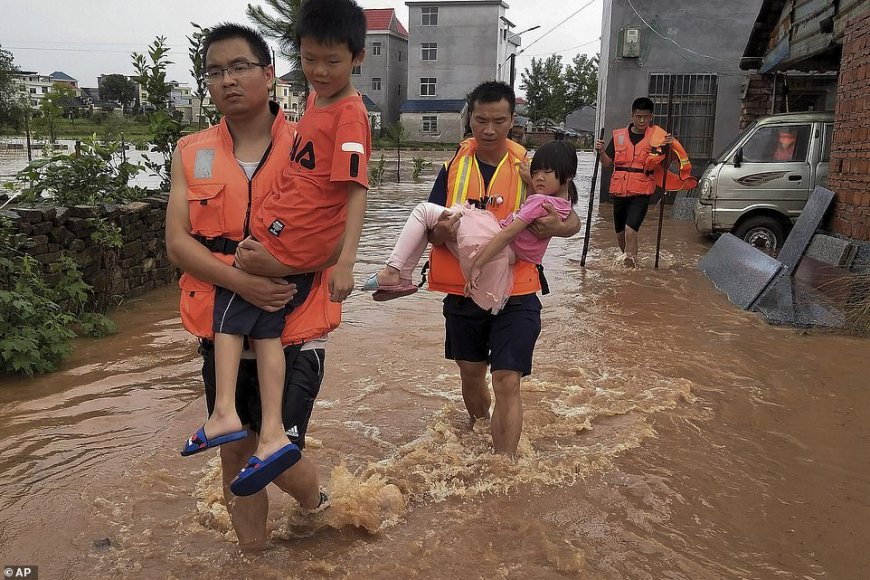Thirty dead as northern China hit by heavy rain, landslides
Severe monsoon rains in northern China, particularly in Hebei province and around Beijing, have claimed at least 30 lives, with many still missing after landslides and flash floods. Torrential downpours triggered evacuations, heavy infrastructure damage, and travel disruptions across 11 provinces.

Severe monsoon rains in northern China, particularly in Hebei province and around Beijing, have claimed at least 30 lives, with many still missing after landslides and flash floods. Torrential downpours triggered evacuations, heavy infrastructure damage, and travel disruptions across 11 provinces. Corporate and government rescue efforts are underway, while climate experts warn that such climate-driven rainfall patterns are becoming increasingly frequent.
-
Fatalities: At least 30 deaths reported due to landslides and flash floods in northern China.
-
Missing Persons: Dozens still unaccounted for—emergency teams are conducting ongoing search operations.
-
Regions Affected: Hebei (including Luanping & Baoding), Miyun area of Beijing, Shanxi.
-
Evacuations: Over 4,400 residents evacuated in the Miyun district alone.
-
Record Rainfall: Fuping in Baoding recorded 145 mm in one hour, exceeding annual norms.
-
Infrastructure Damage: Power outages, submerged roads, disrupted rail services, and reservoir overflow (Miyun at its highest level since 1951).
-
Official Response: Flood warnings issued in 11 provinces, top-level emergency response declared in Beijing.
-
Climate Context: Scientists link intensifying “Plum Rains” to climate change and monsoon shifts.
Multiple landslides in rural Hebei have caused 4 confirmed deaths and left 8 missing. Villages have been severely impacted, with emergency search efforts ongoing.
The Miyun Reservoir received unprecedented inflow (6,550 m³/sec). Flooding swept through local neighbourhoods, submerging vehicles and disabling power to over 10,000 households. Rapid urban evacuations saw more than 4,000 villagers relocated to safer shelters.
Baoding's Xizhuang station reported 540 mm of rainfall in eight hours, exceeding yearly averages. Meteorologists tied the deluge to rapidly forming cloudbursts.
After excerpts from Hebei were included in the total deaths, casualties may rise further.
Heavy rain and flash flooding were reported in Shanxi and Shaanxi provinces, affecting transport corridors and rural areas. In one incident, a driver went missing in Datong city. Rescue teams have been mobilised.
Red Alerts & Preventive Closure Notices
-
The Beijing municipality issued top-level flood alerts, suspended construction, tourism, and outdoor activities until risks subsided.
Evacuations & Relief
-
Over 4,400 residents were evacuated from their homes in Miyun alone. In nearby provinces, thousands were moved away from vulnerable sites.
-
The central government allocated 50 million yuan (USD 7M) to support relief and recovery efforts.
Deploying Rescue Teams
-
More than 1,000 emergency personnel were sent to flood-stricken regions in Henan, Sichuan, and Gansu. Drone, vehicle, and water rescue operations are active.
National Flood Warnings
-
China's Water Resources Ministry issued targeted flood warnings across 11 provinces, particularly for mountain torrents and mid-sized rivers prone to overflow.
-
Modernise Flood Infrastructure: Reinforce dams, urban drainage systems, and river embankments—particularly around Beijing's Miyun reservoir.
-
Expand Warning Networks: Use localized forecasting and rapid alert systems for remote and rural communities.
-
Community Evacuation Protocols: Improve public drills, evacuation shelters, and survivor transport logistics.
-
Climate-Smart Urban Planning: Prioritize flood zoning, green buffers, and sponge city initiatives in urban design.
-
Data Transparency & Monitoring: Centralised casualty reporting, rainfall tracking, and public access to real-time alerts.
The recent tragedy—thirty lives lost, villages submerged, and thousands displaced—shows how vulnerable northern China remains to intensifying rainfall. While swift response from authorities helped prevent greater loss, the root challenge lies in building resilient infrastructure, clearer forecasting, and climate-adaptive planning.

 Ateeq Ur Rehman
Ateeq Ur Rehman